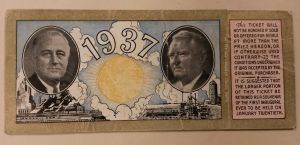
Every four years, on an often cold and wet wintry day, thousands gather on the National Mall and along Constitution Avenue to witness the peaceful transfer of power, as one President steps down and another takes the oath of office. Being located in Washington, DC, the CUA Archives has naturally accumulated images and documents related to the preparations and events that occur before and on Inauguration Day. While we have a number of photos and articles taken by witnesses to the inaugural ceremonies of Presidents from Woodrow Wilson to Richard Nixon, the highlight of our inaugural materials are Taft’s inaugural in 1909 and Roosevelt’s second inaugural in 1937.
While every inauguration is an historic occasion, the 1937 ceremonies stands out in our collections for being both the first swearing-in to occur on January 20 and the first to have a public benediction. And the person who delivered this first benediction was Msgr. John A. Ryan, CUA alumnus and professor. During the contentious election of 1936, Ryan had delivered a speech defending Roosevelt against the criticisms of radio host and Michigan priest Fr. Coughlin. Being a steady ally and faithful advisor to the President on matters of Catholic outreach and minimum wage advocacy, Ryan was invited by Roosevelt in early January to provide the inaugural prayer.

Thanks to Ryan’s personal involvement in this inauguration – also providing the benediction at the 1945 ceremonies – the Archives possesses a number of documents from the beginning of the second Roosevelt administration. From the tickets and programs to the “President’s Platform” seating chart and a parking pass to get through security, Ryan kept the materials from the inaugural he helped bless.
As far as it being the first January inauguration, the Constitution originally specified that the President be sworn in on March 4. With travel much easier and concerns over the Lame Duck period in both Congress and the White House, the passage of the Twentieth Amendment occurred in 1933, moving Inauguration Day to its current date. The 1937 Inauguration thus marked the first time the oath-taking occurred on a blustery January day.
Of course, it was not the first frigid inauguration! Weather was clearly not a factor in determining the date of the presidential swearing-in. As witnessed in the Terence Powderly Photographic Prints collection, snow was a frequent backdrop to the March ceremonies. The 1909 Inauguration is a prime example that the later date did not guarantee a sunny day in Washington!

While Powderly worked on-and-off with Presidents from McKinley to Coolidge, his photographs highlight the spectator side of inaugural set-ups and parades. Present in his collection are images of the parades of both Taft (1909) and Wilson (1913, 1917). The 1909 Inauguration, then held on March 4, witnessed a blizzard the night before. Dumping 10 inches of snow on the city, the storm threatened to cancel the outdoor events, including the traditional parade. While the weather forced the swearing-in to move indoors to the Senate chamber, thousands of city workers labored frantically to clear the parade route. Due to their hard work, the Inaugural Parade proceeded as normal, albeit with many snow drifts visible along the route. (Incidentally, this was also the last year any official Inaugural Ball was held until 1949. When Wilson took office in 1913, he found the concept of galas unbecoming and too expensive and none were held again until Truman’s inaugural.)
No matter the weather – rain, snow, or shine – or the political or social changes that occur, and with or without an accompanying dance, the route of the Inaugural Parade and process of oath-taking has remained a constant in American politics and Washington life.
You can view find out more about the individuals who provide this glimpse into past inaugurations here:

Thanks for posting these items on the local history list-serve — it is very good for the local history community to become familiar with the resources of the CUA archives. (And how I wish we were better informed about the holdings of other universities and organizations around town!) Please continue.
Hayden Wetzel, a sometimes user of the archives